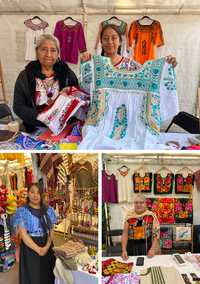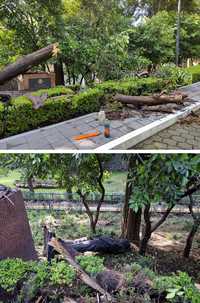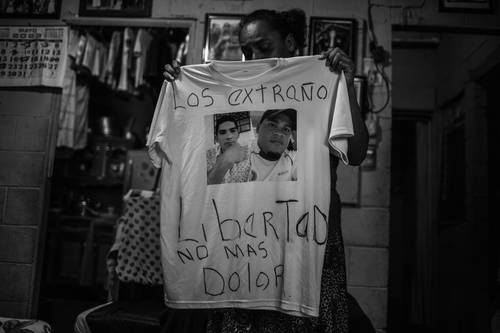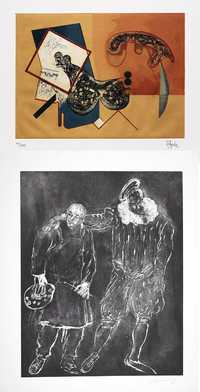The stories of nine indigenous peoples are displayed in an embroidery exhibition.

The stories of nine indigenous peoples are displayed in an embroidery exhibition.
The National Museum of Popular Cultures houses the garments until Sunday, which are also for sale.
Alondra Flores Soto
La Jornada Newspaper, Thursday, July 31, 2025, p. 3
Threads woven onto colorful fabrics represent the nahual coyotes of San Pablo Tijaltepec, a multitude of flowers planted in San Antonino Castillo Velasco, and the leaping deer of Tenango de Doria. Gathered at the fair , "Between Stitches, an Embroidered Story ," they are on display until Sunday at the National Museum of Popular Cultures.
Modernity is also expressed by representatives of indigenous peoples who have brought their work to proudly display and sell it. Laura Quiroz, from the Naa Ñanga collective in the Mixteca region, notes that they make most of their sales through social media or WhatsApp, where people purchase garments online and can even choose shapes, fabrics, colors, and garments according to their taste.
However, unlike the more famous Chinese clothing store (which produces millions of garments a year), it takes artisans between eight months and a year to make a blouse, and the intricate work is offered at a price of about 3,500 pesos.
The 10 members of the Oaxacan collective are also adapting, as they not only make huipiles in white manta, but now use more colors and even denim. Furthermore, after only selling pieces for women, they now make shirts for men and use a sewing machine to join the pieces of fabric. The embroidery technique they use is called pepenado frodido, in which each row of basting is embroidered separately, and once the design is finished, the threads are pulled, gathering the base fabric
. There are no prior drawings; everything is done as the imagination dictates, which entails a learning process of three to five years.
Do me if you can
Sitting in the museum's courtyard, Juliana Martha Serna and her granddaughter Samara Sánchez, originally from San Antonino Castillo Velasco, Oaxaca, name the different types of fraying seen on the blouses they laid out on the table, such as the spider or doll pattern (because the final result is shaped like these toys); there's also the laughter pattern, because you can see the little teeth and it's very difficult.
“The most important one for us is 'Have me if you can,' which represents a man-woman-man-woman marriage. Everyone holds hands because we do the Guelaguetza or the tequio when we help out at the wedding, the fandango, or the mayordomía. They are living stories,” says Doña Juliana.

▲ Representatives from eight states proudly display their creations. A single garment can take up to a year to make. Photo by Alondra Flores
Furthermore, they show the woven shores, which are precisely the water that runs through our Mother Earth
. She happily points out that this is a very beautiful day for us because it is a recognition of our work
. The craft fair began yesterday, World Embroidery Day, which has been celebrated since 2011. Each of these stitches tells a story, and ours is floriculture, which is why we revisit flowers for our dresses. For example, there are multicolored blouses, because just as penumbres, dahlias, or even sunflowers come in many colors thanks to the florists' modifications, garments also boast a plurality of tones. It means that our land is very bountiful; this is what our embroidery tells us
.
In the museum's courtyard, located in the center of Coyoacán, 24 exhibitors from eight states showcase their work based on the traditions of nine indigenous peoples: Amuzgo, Ayuuk, Otomi, Nahua, Tsotsil, Tseltal, Mazahua, Mixtec, and Zapotec.
Among the variety of handcrafted products, in addition to clothing and objects, there are options for the palate, such as coffee from Chiapas and bread from Tepetzintla, Veracruz. There are many stories of oil in this area
, they share while offering a taste of cookies made with corn, lard, and piloncillo. They say that making them takes time, especially because the corn must be thoroughly dried and then ground by hand. The clay oven is heated with firewood; once it reaches the ideal temperature for baking, the embers are removed and the bread or cookies are placed inside.
In addition to the product exhibition and sales, various free activities will be held throughout the weekend at the National Museum of Popular Cultures (Hidalgo Avenue 289, Del Carmen neighborhood, Coyoacán). Today, at 4:00 p.m., the documentary Saberes ancestrales de las mujeres milpaltenses (Ancestral Knowledge of Milpaltense Women ) will be presented, and tomorrow, at the same time, there will be a presentation of Otomi music with Graciela Sebastián Morelos.
Calderón's statue will be reinstalled in Los Pinos to commemorate the site's history.
Reyes Martínez Torrijos
La Jornada Newspaper, Thursday, July 31, 2025, p. 4
The statue of Felipe Calderón, which was felled by a tree on the night of July 24, must be reinstalled where it stood because it is part of the history of the place,
said Elisa Lemus Cano, director of the Los Pinos Cultural Complex.
The official explained to La Jornada that the piece has historical value, as it forms part of the site's heritage and the history of the institution she manages. Our job is to safeguard the space and the works housed here, including the furniture, statues, houses, and so on. We remain very independent of any political stance
.
He added that the work, created by Ricardo Ponzanelli to a much larger size than the character, suffered a broken right leg and was knocked to the ground when a tree trunk hit it from the left side. He emphasized that no fragments were lost. The forest expresses itself. It has its own dynamics, and this is a consequence of the fact that it has its own life
.
The cultural manager mentioned that Los Pinos has more than 500 trees and the one that tore down the figure of Calderón already had a hollow natural body and, due to the weight of the rain on its trunk, it fell
.
The forest is going to act
It's a matter of circumstance, he added: Los Pinos is a cultural center in a natural space: a forest and its ecosystem. Regardless of what's been installed in this area, the forest will act. Unfortunately, it falls on one of the pieces
.

▲ On the night of July 24, a tree knocked down the sculpture mounted on the Presidents' Causeway at the Los Pinos Cultural Complex. Photo courtesy of the Federal Ministry of Culture.
The pieces that form part of the Los Pinos historical collection are insured by Agroasemex. In the event of an incident, a protocol must be followed, which includes covering the piece, which in this case was done with thick black plastic, Lemus Cano said.
The firm conducted an inspection on July 25th and assessed the insurance coverage. Yesterday morning, authorization was granted to move the work, so it was cleaned, packed, and moved to a warehouse at the cultural complex. During this process, it was determined that the figure's right leg was broken between the knee and the foot.
Between now and next Monday , the actual damage assessment will be completed, and the next step is to determine a date or time for the restoration and delivery to the complex, as well as its reinstallation on its pedestal
. During this phase, the insurer must hire a bronze specialist who knows how to repair the leg structure that separated from the rest of the piece.
Elisa Lemus recalled that a census of the trees in the cultural space was conducted. We are in the process of removing those in deterioration and performing phased pruning, with the supervision and support of the various institutions involved
.
Today, World Press Photo 2025 opens at the Franz Mayer Museum.

▲ Life and death in a country without constitutional rights , image by Salvadoran journalist Carlos Barrera, where Cecilia Abrego appears holding a T-shirt with photographs of her children, detained and imprisoned in May 2022.
Angel Vargas
La Jornada Newspaper, Thursday, July 31, 2025, p. 4
The independent organization World Press Photo (WPP), based in Amsterdam, Netherlands, is very clear about its position on the genocide in Gaza: Unfortunately, it is very difficult, and we join the call of all media outlets, because journalists are also dying of hunger while doing their work
.
This was announced by Babette Warendorf, exhibitions director at the WPP Foundation, who is visiting Mexico to attend the opening of the World Press Photo 2025 exhibition, which opens today at the Franz Mayer Museum and runs through October 12.
During a media tour, the Dutch curator emphasized that for the second consecutive edition, the winning image of this competition relates to that conflict and its repercussions among the Palestinian civilian population.
"I'm afraid we're going to see a lot more photos of the Gaza war this year because it's not over yet
," he said, prompting reporters to ask him about WPP's position on Israel's military attacks on the Palestinians.
We focus a lot on press freedom, and we see that Gaza has been the deadliest conflict for journalists in the world. To date, more than 160 have been killed in Gaza. For us, the most important thing is that journalists have the freedom to work
, he responded.
Earlier, at a press conference, Babette Warendorf warned that press freedom is deteriorating year after year around the world, and that, in this regard, Mexico remains one of the most dangerous countries
for practicing journalism.
He mentioned a report by Reporters Without Borders, which ranks our country 124th out of 180 countries in press freedom, after more than 150 journalists have been murdered since 2000 and 28 have disappeared.
Another topic addressed by the WPP exhibitions director was the organization's 70th anniversary, which is being celebrated this year. She explained that, to mark the anniversary, they received additional funding to display their collection to the public and hire an archivist who is now working to put it in order.
In one of the most anticipated exhibitions at the Franz Mayer Museum (Hidalgo Avenue 45, Downtown), World Press Photo 2025 presents 144 of the most striking images of photojournalism and documentary photography captured in various corners of the planet throughout 2024.
The winners were selected from among 59,320 photos submitted by 3,778 photographers from 141 countries, evaluated by regional juries and then by an independent global jury.
The 2025 edition features 42 winning projects, nine more than the previous year, which, according to the organizers , represents a significant increase in the diversity of voices, regions, and approaches
. However, unlike past editions, no Mexicans are included.
Divided into six sections, dedicated to each of the planet's geographical areas, the tour concludes with the winning image of the current edition of the WPP: Palestine , in which Gaza-born photographer Samar Abu Elouf captured her young compatriot Mahamoud Aljjour, a 9-year-old boy who lost both arms while escaping an Israeli attack with his family, brooding in a play of chiaroscuro.
Donations to Munae encourage exhibitions by Felguérez and Gilberto Aceves
Merry MacMasters
La Jornada Newspaper, Thursday, July 31, 2025, p. 5
Four years ago, Mercedes Oteyza, widow of Manuel Felguérez (1928-2020), donated 35 individual works and three portfolios, covering the period 1986-2019, to the Museo Nacional de la Estampa (Munae). Last year, Juan Aceves, son of the artist Gilberto Aceves Navarro (1931-2019), donated 329 works to the same museum.
Both gestures of generosity enliven the pair of exhibitions that will open on Saturday at the Munae: Manuel Felguérez Irruption: Mercedes Oteyza Donation , curated by Lilia Prado, and Obsessions in Motion: Graphic Flow by Gilberto Aceves Navarro , curated by Luis Ignacio Sáinz.
The first is complemented by three silkscreens from the folder Differences and Continuity , with 24 aphorisms by Juan García Ponce, which belongs to the Munae collection; three sculptures from Felguérez's workshop; and two of his latest oil paintings, which he made in 2020. Obsessions in Motion are joined by two acrylics on the theme of bullfighting, from the Museum of Modern Art (MAM), a venue preparing the exhibition Becoming a Line , featuring work by Aceves Navarro, for next October.
After reviewing the four decades of work represented in the donation, Prado refers to Felguérez as an explorer and visionary
. "The Zacatecas artist is always relevant because we all have an abstract mindset
," he tells La Jornada . The master left his mark on both modern and contemporary art
. A member of the Rupture Generation, he said that it was more of an opening toward new languages
.
For the curator of the Munae, another constant in Felguérez's production is his irruption
, hence the title of the exhibition, because although he trained in sculpture in Europe, he apparently later moved to painting for practical reasons, although he never stopped creating graphic art
. In fact, the artist worked in graphic art in a wide variety of workshops, such as Ediciones Multiarte, Tiempo Extra Editores, the Intaglio Graphic Workshop at the Centro Cultural Estación Indianilla, and the Taller Jesusa, not to mention the engraving workshop at the Manuel Felguérez Museum of Abstract Art in Zacatecas.
The exhibition is divided into three thematic sections that refer to constructive geometry, organic geometry, and matter and gestures. To set the scene for the entire work, Felguérez's work table is also included , just as he left it
, along with his famous pipe.

▲ Leda (1987), sugar etching and aquatint by Manuel Felguérez, and Untitled Piece (Don Felipe II and His Painter) (2000), aquatint and etching by Gilberto Aceves Navarro. Photo courtesy of Munae/Inbal
Wandering without a compass
Obsessions in Motion: Graphic Flow by Gilberto Aceves Navarro comprises a selection of 75 prints, five engraving plates and the two oil paintings from the MAM, 82 works in total in techniques and presentations such as electrostatic printing, silkscreen printing, digital graphics, etching, drypoint, aquatint, burin engraving and monotype.
For Luis Ignacio Sáinz, in the forest of gouges and burins, and the parade of pigments, Aceves Navarro wanders without a compass, but with a direction as Gilberto Owen would mark, defying the conventions of good consciences. He joyfully pursues a playful meaning for his refined imagery. He does so convinced that the relevance of art lies, literally nestles, in its treasured capacity for surprise. That's why he strives to seek out those small, subtle delights that are transgressions: the crimes of a thinking sensibility
.
According to the specialist, Aceves Navarro was a liberal in every sense of the word. A critical democrat, he was always concerned with social, indigenous, working-class, and religious, ethnic, and sexual minority causes
. His body of work is vast
, with women at the forefront, toward whom he always had an ambivalent attitude of fascination and admiration, though also with certain misogynistic touches, a trait of his generation and his personal biography
.
The title of the exhibition reflects the fact that "the work of reflection and research that Aceves Navarro carries out to engrave a plate and print a print is expressed in the expression "Obsessions in Motion ," which refers to the total dedication to a theme-object-situation-entity until it is completely broken down and mastered, carrying out such activities dynamically. This means that what is represented is transformed as it moves through space."
The second part of the title, Graphic Flow , alludes to the almost infinite number of tests, sketches and drawings that Aceves Navarro makes of each image chosen to be engraved on the metal plate and printed on the paper that circulates in the printing press
.
Both exhibitions will open on Saturday at 1 p.m. at the National Print Museum (Hidalgo Avenue 39, Plaza de la Santa Veracruz, Historic Center).
jornada





